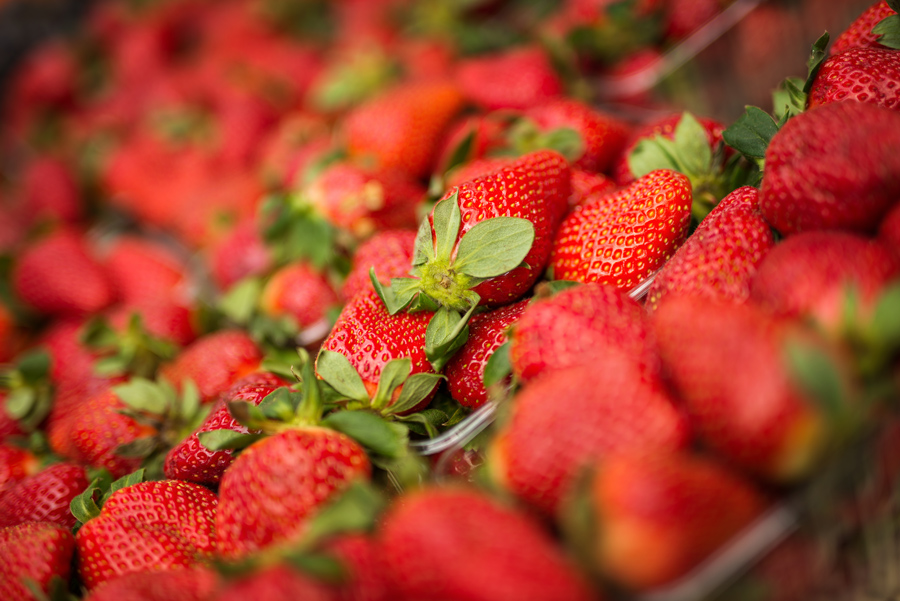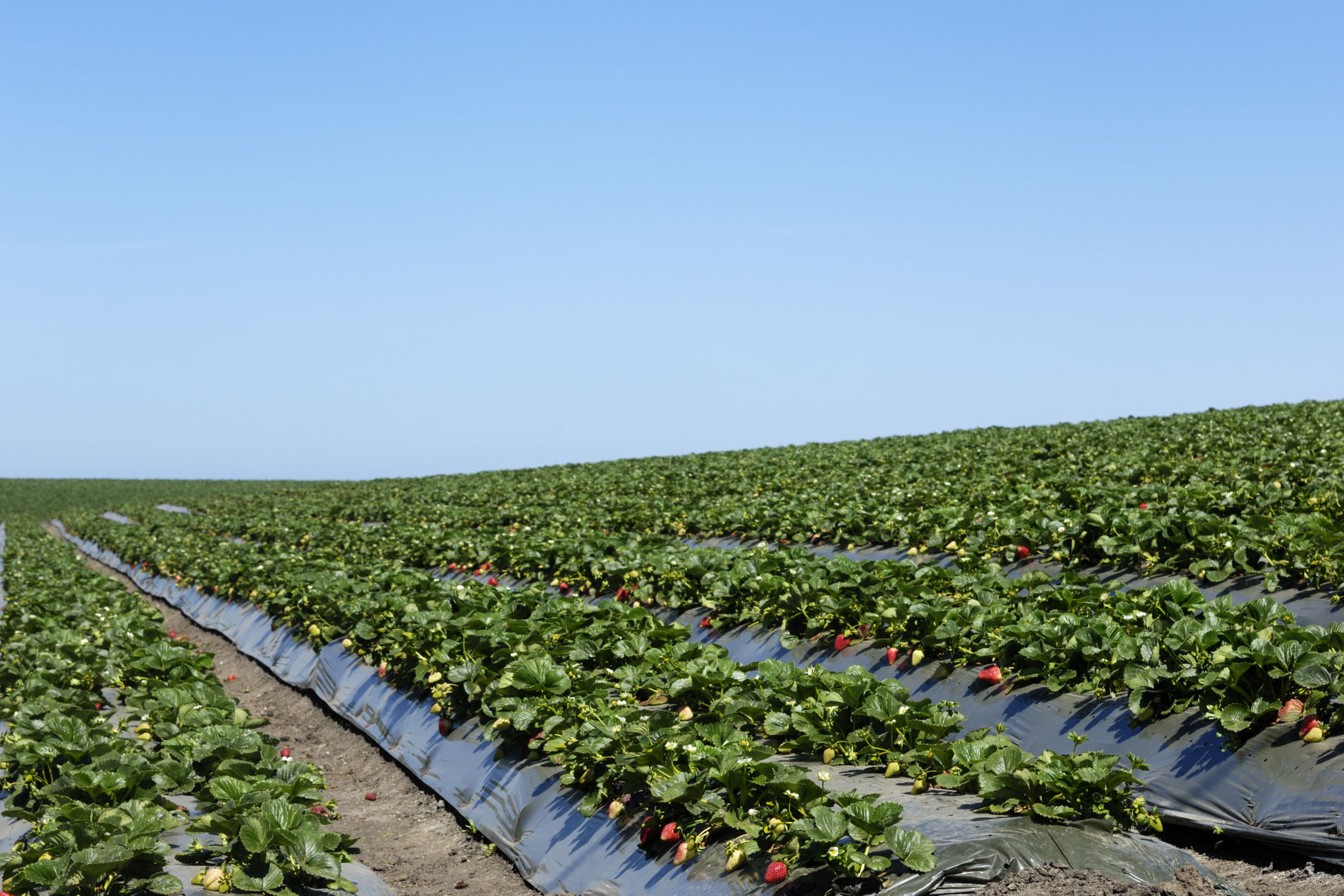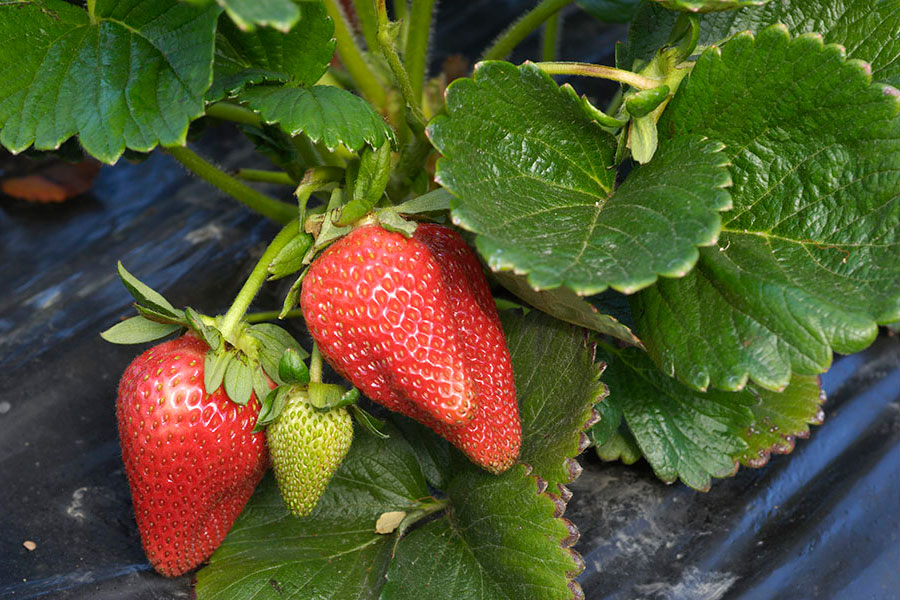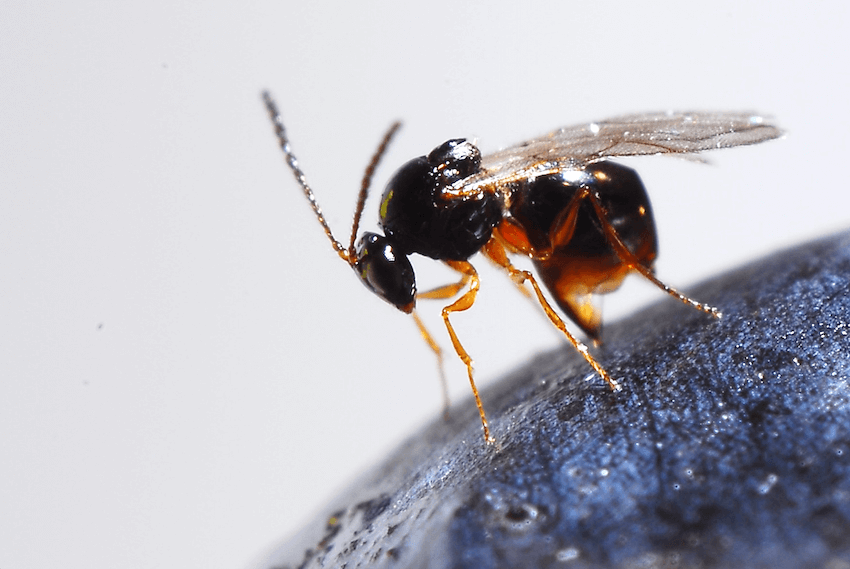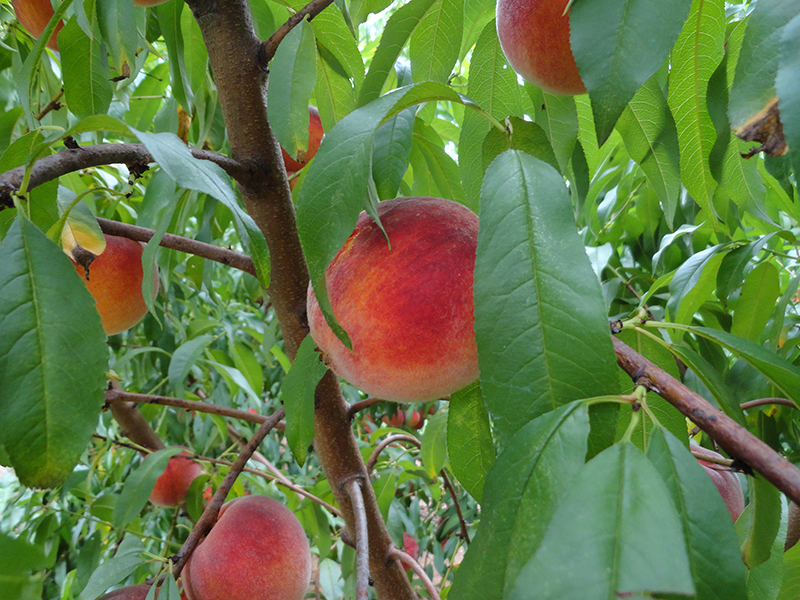This publication reports on a strawberry variety trial conducted in order to assist producers in choosing a variety or varieties best suited to the South Georgia climate while maximizing quality and yield.
Strawberries in Georgia
The Georgia strawberry (Fragaria × ananassa) industry is relatively small, with just 143 acres in production (Georgia Grown, n.d.) and a farm gate value of approximately $15.3 million in 2022, up from $9.4 million in 2017 (Center for Agribusiness and Economic Development, 2024). Georgia’s industry relies upon older varieties such as ‘Chandler’, ‘Sweet Charlie’, and ‘Camarosa’, which have been largely phased out of production in California and Florida but offer consistent yields and quality fruit under South Georgia’s winter climate (with production starting in late January).
Newer short-day varieties have the potential to outperform these older varieties in South Georgia climatic conditions (Table 1). Production in South Georgia could potentially increase with the adoption of new varieties that have been developed for annual hill production and current postharvest handling processes (Melendez, 2016). The coastal plains of Georgia have a moderate climate with mild and short winters. Day-neutral and long-day varieties are not considered acceptable in this region because of the extended season brought on by late flowering. Late-flowering varieties would delay harvesting and expose fruits to high temperatures (> 85 °F), which is known to reduce fruit quality.
| Variety | Breeding program | Release year | Photoperiod | Postharvest qualities |
|---|---|---|---|---|
| Albion | UC | 2006 | day neutral | ~8.8° Brix, moderate TA (~1.77%) |
| Cabrillo | UC | 2015 | day neutral | Comparable to other day‑neutrals (good flavor/shelf life) |
| Calinda | Fresh Forward Breeding | 2014 | short day1 | Firm, juicy fruit with excellent sweetness and transport resilience |
| Camarosa | UC | 1992 | short day | Very firm fruit; edible coatings extend ~9-day shelf life |
| Camino Real | UC | 2001 | short day | Firm, dark-red, ~27 g; ~7.6° Brix, TA ~1.60% |
| Florida Beauty | UF | 2017 | day neutral2 | Excellent flavor and sweetness |
| Florida Brilliance | UF | 2008 | day neutral | Firm fruits with good shelf life |
| Florida Radiance | UF | 2008 | short day | Firm fruits with moderate acid content |
| Fronteras | UC | 2014 | short day | Large, firm, and deeply colored with excellent flavor |
| Merced | UC | 2013 | short day | Large, heat-tolerant; ~8.2° Brix, low TA (~1.52%) |
| Ruby June | Lassen Canyon Nursery, Inc. | 2014 | short day | Excellent flavor; high Brix; low cull loss, strong firmness |
| Sensation® | UF | 2013 | short day | Firm fruits with good shelf life |
| Strawberry Festival | UF | 2000 | short day | Standard in Florida for firm fruits |
| Note. UC = University of California; UF = University of Florida; TA = titratable acidity 1 short day is also known as June-bearing 2 noted as weak day-neutral |
||||
Strawberry Harvesting and Fruit Quality
Strawberries are nonclimacteric fruit, which means that they do not ripen after harvest, showing only minimal color changes. Thus, fruit must be harvested at its optimum eating quality, and that quality must be maintained through the supply chain to the consumer. Growers will typically pick fruit when it is visually 75% red in color or greater, sacrificing flavor, taste, and nutritional quality for firmer fruit (Taghavi et al., 2019). Local producers who do not need to ship their fruit to distant markets can opt to pick fully ripe fruit instead of lower-quality fruit.
In addition, strawberries are one of the most perishable fruits, being very susceptible to mechanical injury, water loss, decay, and physiological deterioration (Nunes et al., 1995). The majority of fruit quality attributes—e.g., fruit firmness, color, fruit shape, etc.—are known to be genetically controlled. The extent to which genetics controls berry-quality attributes is directly related to the crop’s lifespan—i.e., the effect is greater for perennial crops than annual crops (Prange & DeEll, 1997).
Cultivars Selected for This Study
Cultivars included in this study were: University of California-licensed ‘Albion’, ‘Cabrillo’, ‘Camarosa’, ‘Camino Real’, ‘Fronteras’, and ‘Merced’; University of Florida-licensed ‘Florida Beauty’, ‘Florida Brilliance’, ‘Strawberry Festival’, ‘Florida Radiance’, and ‘Sensation’. Cultivars from independent breeding programs included a Lassen Canyon Nursery variety, ‘Ruby June’, and a variety from Fresh Forward Breeding (based in the Netherlands), ‘Calinda’ (see Table 1).
Planting, Production, and Harvesting Methods
Annual hill culture was used with polyethylene film mulch, drip irrigation, 28-in.-wide by 10-in.-high beds set 5 ft on center and planted in double rows, with 14 in. between plants and 12 in. between rows. Seventy-five plants of each variety were planted at a strawberry farm located in Lowndes County, GA, on Tifton loamy sand (fine loamy, kaolinitic, thermic Plinthic Kandiudults) on November 2, 2019. In general, 10% to 15% plant loss during transplanting is expected. During the first 2 weeks of establishment, producers often will reset plants to maintain their stand. After the first 2 weeks, any new gaps are left.
All crop production practices followed current recommendations from the University of Florida for raised-bed strawberry production (Whitaker et al., 2021).
After transplanting, strawberry plants were established, allowed to go into dormancy between late November and early January, and were covered with floating row covers to protect them from cold temperatures when needed.
Harvesting was performed on an as-needed basis, two to three times a week, beginning late January until mid-February. Strawberries were harvested by hand using commercial standards, placed in coolers, and transported to the Vidalia Onion Research Laboratory in Tifton for quality evaluations. Variables measured at harvest were yield, fruit firmness, soluble solid contents, and external fruit color.
Postharvest Storage Tests
Two 7-day-postharvest storage tests were started on the harvest dates of February 14 and March 16, 2020. Strawberries were stored in plastic clamshells and held in temperature-controlled cold rooms at 32 (± 1) °F and 90% to 95% relative humidity. After storage, the following variables were assessed: weight loss, firmness, external color, and visual quality. Strawberry visual quality was assessed using a 1 to 5 rating scale (Pelletier et al., 2011):
- 5 = very good; freshly harvested fruit, fruit are firm and turgid, there are no signs of bruising, shriveling, or decay;
- 4 = good; fruit are firm but with some small bruises;
- 3 = fair; fruit exhibit minor signs of softness, shriveling is evident, and bruises are visible, but there is no visible decay;
- 2 = poor; fruit are very soft, very bruised, overripe, and decay is evident on some fruit; and
- 1 = very poor; fruit are extremely overripe, there are leaky fruit, and partially or completely rotten fruit.
Berry Quality at Harvest
Based upon the field portion of this study, the highest yielding varieties also had the best storage life: ‘Camino Real’, ‘Strawberry Festival’, and ‘Camarosa’ (Table 2). These varieties had estimated yields of 8,621, 6,813, and 6,403 lb per acre, respectively, when using a density of 19,000 plants/acre.
| Variety | Survival rate | First harvest date | Yield (g/plant) |
Harvest season length (days) |
|---|---|---|---|---|
| Albion | 80% | 02/11/2020 | 42.6 | 33 |
| Cabrillo | 58% | 01/28/2020 | 66.7 | 48 |
| Calinda | 89% | 01/28/2020 | 153.6 | 48 |
| Camarosa | 100% | 02/04/2020 | 153.0 | 42 |
| Camino Real | 100% | 01/22/2020 | 206.0 | 54 |
| Florida Beauty | 78% | 02/04/2020 | 41.9 | 42 |
| Florida Brilliance | 77% | 01/28/2020 | 66.9 | 48 |
| Florida Radiance | 56% | 01/28/2020 | 72.0 | 48 |
| Fronteras | 72% | 01/28/2020 | 50.6 | 48 |
| Merced | 100% | 02/07/2020 | 69.8 | 37 |
| Ruby June | 100% | 02/14/2020 | 58.8 | 30 |
| Sensation® | 49% | 01/28/2020 | 44.0 | 48 |
| Strawberry Festival | 100% | 01/28/2020 | 162.8 | 48 |
Berry Yield
Georgia’s average production per acre for strawberries is unknown as the USDA discontinued state-average determination in 2019 (National Agricultural Statistics Service, 2021). The estimated yields for this study are similar to the average yields in 2019 for Oregon, Washington, and North Carolina, which ranged between 10,000 to 12,500 lb/acre. These results are similar to those from a strawberry variety trial conducted in Quincy, FL, in 2006 (Santos et al., 2007) where ‘Camino Real’, ‘Strawberry Festival’, and ‘Camarosa’ yielded 14,800, 19,400, and 23,200 lb/acre, respectively.
It is important to note that our estimated yields are based upon a 4- to 7-week harvesting window in 2020 that was halted abruptly because of the COVID-19 pandemic. A typical harvesting season could last up to 8 to 12 weeks, depending upon weather conditions.
Berry Size
Besides total yield, the average berry size is an important factor to consumers. Typically, marketable strawberry fruits are those greater than 10 g (0.35 oz). Varieties that have average fruit size greater than 20 g (0.70 oz) are considered for annual production systems. Larger fruits are attractive to consumers and result in increased harvesting efficiency (Whitaker et al., 2011). Nine out of the 13 varieties trialed met this requirement (Figure 1).
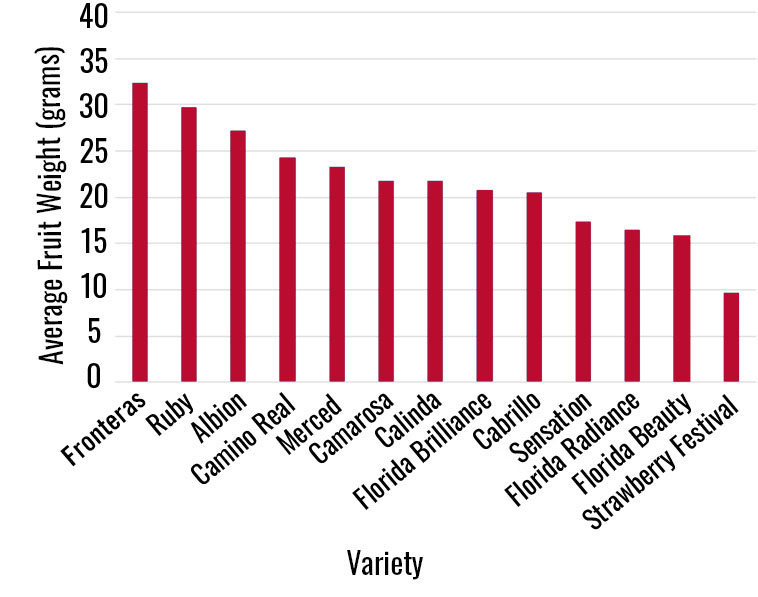
Of the top-three-yielding varieties in the study, only ‘Strawberry Festival’ did not have an average fruit weight over 20 g (0.70 oz), instead producing fruit with an average weight of 9.6 g (0.34 oz). Despite the smaller average fruit size, ‘Strawberry Festival’ plants produced a higher number of berries, with the primary feature of the variety being its early yield (Chandler et al., 2000). ‘Strawberry Festival’ tends to have large-sized conical-shaped fruits that are easily packed into clamshells, which makes it a favorite of both growers and consumers.
Berry Firmness
Other quality attributes assessed at harvest were fruit firmness, total soluble solids (Brix°), and external fruit color. Overall, the varieties with the firmest fruits tended to be the lowest-yielding varieties (‘Florida Brilliance’ and ‘Cabrillo’). The top-four-yielding varieties (‘Camarosa’, ‘Calinda’, ‘Camino Real’, and ‘Strawberry Festival’) were all similar to each other in terms of firmness. ‘Camino Real’ in particular increased in fruit firmness as the season progressed (Figure 2). The firmness of ‘Calinda’, ‘Camarosa’, and ‘Strawberry Festival’ remained between approximately 175 and 300 gram-force (0.39 to 0.66 lbf) over the whole season (Figure 2). Gram-force (gF) or pound-force (lbf) measures the pressure applied to strawberries by inserting an 8-mm probe into the fruit to a depth of 10 mm.

Total Soluble Solids (Brix)
For strawberries, the minimum requirements for flavor acceptability are a soluble solids content of 7% or greater and a maximum titratable acidity of 0.8% (Mitcham, 2016). For this study, there was not a large difference in total soluble solids content between varieties studied on each day of harvest. Soluble solids content ranged from 6.0% to 10.5% over the whole season depending upon variety (Figure 3).

‘Merced’ had the highest soluble solids content at the end of the season, making it unique—rising temperatures in the spring are said to be responsible for a decline in soluble solids content toward the end of the winter strawberry season (MacKenzie & Chandler, 2009). Based upon the historical weather data for the season, temperatures started to increase above 85 °F around the second week in March (Figure 4). These increased temperatures corresponded to the decreasing soluble solids content seen around the same time in Figure 3.
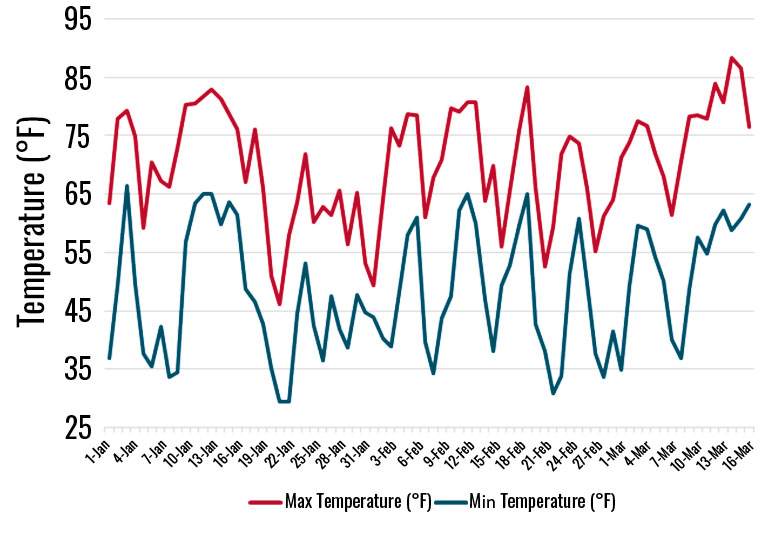
Berry Color
No differences between the varieties were found for fruit color. All 13 varieties at harvest were approximately the same red color (data not presented).
Quality After 7-Day Cold Storage
The 7-day-postharvest storage tests were limited to the varieties that had an adequate number of fruit on the harvest dates (February 14 and March 16, 2020). These varieties were ‘Camarosa’, ‘Florida Brilliance’, ‘Florida Beauty’, ‘Strawberry Festival’, and ‘Ruby June’.
During storage, ‘Florida Brilliance’ lost the least amount of moisture over 7 days, roughly 0.4%, versus ‘Florida Beauty’, which lost about 1.15% over the same duration (Figure 5). Weight loss during storage results in fruits that are shrunken, less glossy, and prone to postharvest decay, which consequently results in lower visual-quality scores (Figure 6). Both ‘Camarosa’ and ‘Strawberry Festival’ lost between 0.6% and 0.9% of their weight after the 7-day cold-storage period.
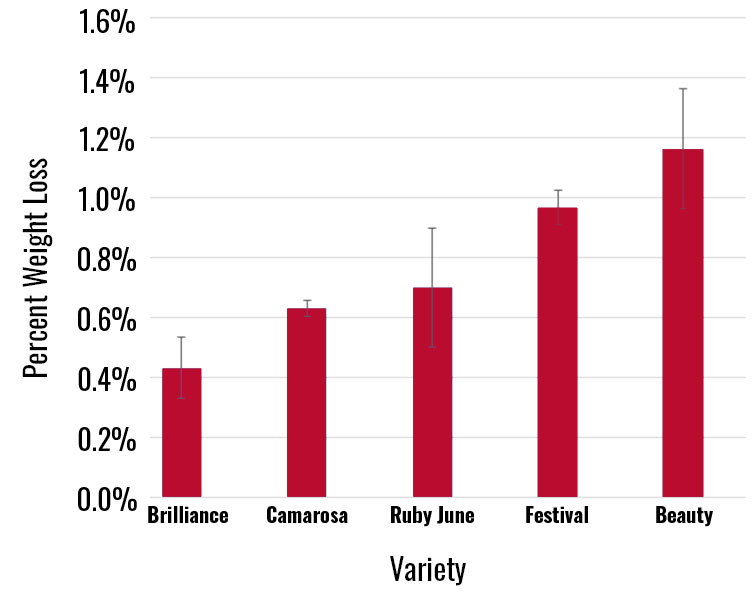

Overall, the weight-loss amounts were minimal because of the stable, low-temperature conditions and the high relative humidity environment in the cold room. Fruit firmness after 7 days of storage showed very little change. ‘Florida Brilliance’ and ‘Florida Beauty’ had the firmest fruits with 250 to 280 gram-force (0.55 to 0.62 lbf). Both ‘Strawberry Festival’ and ‘Camarosa’ fruits had similar firmness with 245 to 260 gram-force (0.54 to 0.55 lbf) before and after 7 days of storage (Figure 7).
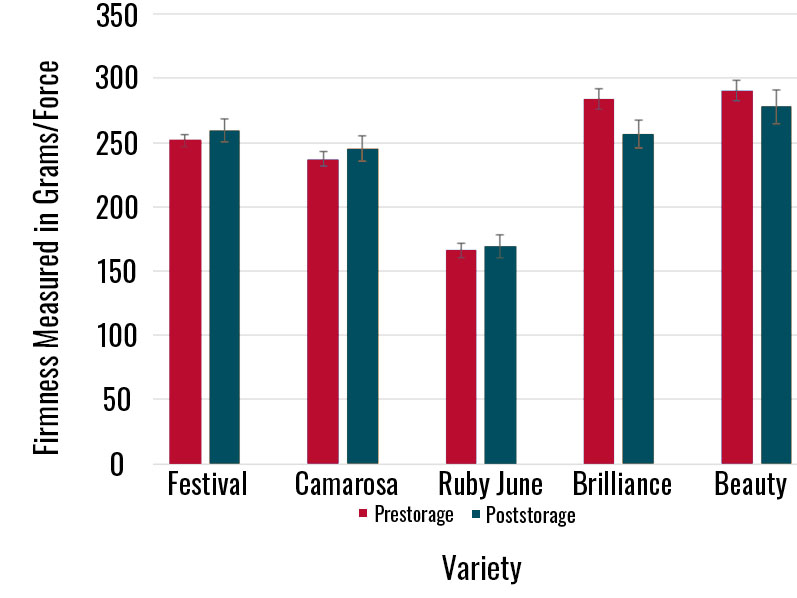
Conclusions
- In South Georgia, only short-day varieties should be considered to maximize the harvesting window of late winter to early spring.
- We recommend growers try a small test plot of any new variety added to a farm operation and test it for a minimum of 2 years.
- Our study found that ‘Camino Real’, ‘Camarosa’, and ‘Strawberry Festival’ were the highest yielding varieties with moderate firmness and moderate total soluble solids content.
References
Center for Agribusiness and Economic Development. (2024). Georgia farm gate value report 2022 (Report No. AR-24-0). University of Georgia College of Agricultural and Environmental Sciences. https://caed.uga.edu/publications/farm-gate-value.html
Chandler, C. K., Legard, D. E., Dunigan, D. D., Crocker, T. E., & Sims, C. A. (2000). ‘Strawberry Festival’ strawberry. HortScience, 35(7), 1366–1367. https://doi.org/10.21273/HORTSCI.35.7.1366
Georgia Grown. (n.d.). Strawberries. Georgia Department of Agriculture. https://georgiagrown.com/find-georgia-grown/fruits-vegetables/strawberries/
MacKenzie, S. J., & Chandler, C.K. (2009). The late season decline in strawberry fruit soluble solid content observed in Florida is caused by rising temperatures. Acta Horticulturae, 842, 843–846. https://doi.org/10.17660/ActaHortic.2009.842.186
Melendez, M. (2016). Ultra-niche crops series: Plasticulture strawberries postharvest handling & food safety (Publication No. FS1258). New Jersey Agricultural Experiment Station, Rutgers University. https://njaes.rutgers.edu/fs1258/
Mitcham, E. J. (2016). Strawberries. In K. C. Gross, C. Y. Wang, & M. Saltveit (Eds.), The commercial storage of fruits, vegetables, and florist and nursery stocks (Agricultural Handbook No. 66; pp. 559–561). U.S. Department of Agriculture Agricultural Research Service. https://www.ars.usda.gov/arsuserfiles/oc/np/commercialstorage/commercialstorage.pdf
National Agricultural Statistics Service. (2021). Noncitrus fruits and nuts 2020 summary. U.S. Department of Agriculture. https://downloads.usda.library.cornell.edu/usda-esmis/files/zs25x846c/sf269213r/6t054c23t/ncit0521.pdf
Nunes, M. C. N., Brecht, J. K., Morais, A. M. M. B., & Sargent, S. A. (1995). Physical and chemical quality characteristics of strawberries after storage are reduced by a short delay to cooling. Postharvest Biology & Technology, 6(1–2), 17–28. https://doi.org/10.1016/0925-5214(94)00048-W
Pelletier, W., Brecht, J. K., Nunes, M. C. N., & Émond, J. (2011). Quality of strawberries shipped by truck from California to Florida as influenced by postharvest temperature management practices, HortTechnology, 21(4), 482-493. https://doi.org/10.21273/HORTTECH.21.4.482
Prange, R. K., & DeEll, J. R. (1997). Preharvest factors affecting postharvest quality of berry crops. HortScience, 32(5), 824–830. https://doi.org/10.21273/HORTSCI.32.5.824
Santos, B. M., Chandler, C. K., Olsen, S. M., & Olczyk, T. W. (2007). Performance of strawberry cultivars in Florida. Proceedings of the Florida State Horticultural Society, 120, 155–156. https://journals.flvc.org/fshs/article/view/86212
Taghavi, T., Siddiqui, R. & Rutto, L. K. (2019). The effect of preharvest factors on fruit and nutritional quality in strawberry. In T. Asao & M. Asaduzzaman (Eds.), Strawberry – Pre- and post-harvest management techniques for higher fruit quality. IntechOpen. https://doi.org/10.5772/intechopen.84619
Whitaker, V. M., Hasing, T., Chandler, C. K., Plotto, A., & Baldwin, E. (2011). Historical trends in strawberry fruit quality revealed by a trial of University of Florida cultivars and advanced selections. HortScience, 46(4), 553–557. https://doi.org/10.21273/HORTSCI.46.4.553
Whitaker, V. M., Peres, N., Lahiri, S., Park-Brown, S., & Chandler, C. K. (2021). Growing strawberries in the Florida home garden (Publication No. HS1154). https://edis.ifas.ufl.edu/publication/hs403

